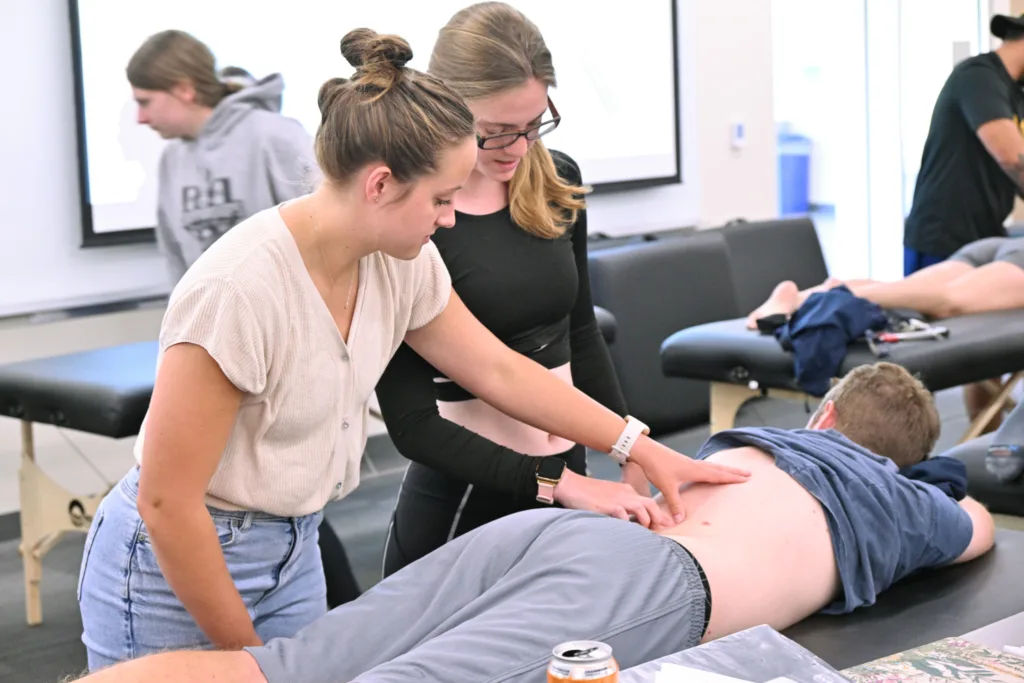Advanced Techniques in Athletic Training: Manual Therapy and Hands-On Approaches
Unless you are an athletic trainer or physical therapist, you may have never heard of manual therapy. And even within the profession, some practitioners know many manual therapy techniques and use them often, while others may know few techniques and do not use them at all. Here at the University of Idaho, we believe in equipping our athletic training students with a broad spectrum of tools in their toolbox, including many manual therapy techniques. Why? We know that every patient, every injury, and every rehabilitation is different. A technique that helps one patient might not help the next, or even the same patient’s next injury. Teaching our students a broad range of treatment options and paradigms means that they can be more effective clinicians, and help their patients recover faster.
In this blog we’ll cover these big questions.
- What is manual therapy?
- How can athletic trainers use manual therapy in their patient care?
- What are some common techniques?
- If a practitioner is interested in increasing their knowledge of manual therapy, what options are available?
Overview of manual therapy
In manual therapy the practitioner uses their hands or specialized instruments to target a variety of anatomical structures, usually designed to regain movement, activate muscles, and reduce inflammation. These techniques can be used by themselves, or in conjunction with other treatments such as modalities or therapeutic exercise. Aside from athletic trainers, manual therapy is used mainly by physical, occupational, and massage therapists, and chiropractors.
Manual therapy for athletic trainers
Athletic trainers are well-poised to practice manual therapy and perform ongoing research on its use. Why? Insurance doesn’t usually reimburse well for manual therapy, but unlike other rehabilitation specialists, athletic trainers often do not bill through insurance. This means they have more leeway to try manual therapy and research the effectiveness of different techniques.
What are some manual therapy techniques?
Here at the University of Idaho, we teach our students many different manual therapy techniques. We want our students to have as many different tools in their toolboxes as possible, as not every technique works for every patient. Here are some of the manual therapy techniques we teach and use here at the University of Idaho:
- Positional Release Therapy (PRT).
- Instrument Assisted Soft Tissue Mobilization (IASTM): This intervention manipulates the skin, myofascial, muscles, and tendons with specialized instruments, usually made of stainless steel.
- MyoKinesthetic System (MYK): This is a different approach to pain relief that focuses on stimulating the central nervous system through bilateral movements and muscle sensory stimulation.
- The Mulligan Concept of Manual Therapy: The Mulligan Concept is a method of applying pressure to a joint while the joint is in motion to reduce pain and increase mobility and functionality.
Certifications in manual therapy
Some manual therapy techniques offer certification, but there is no overarching manual therapy certification for athletic trainers. In some situations, a practitioner may not be able to practice a manual therapy technique, even if they are certified. For example, a practitioner may earn dry needling certification for athletic trainers, but dry needling is banned in several states, including our neighbors Oregon and Washington. Similarly, there is a cupping certification for athletic trainers, but state law may not allow an athletic trainer to practice cupping. For instance, cupping is only legal in California if it is performed by a licensed acupuncturist.
If a practitioner is interested in increasing their knowledge of manual therapy, there are several options available.
- Continuing Education Credits: There are many CEU’s available for athletic trainers that focus on various manual therapy techniques.
- For athletic trainers that are interested in taking a deeper dive into manual therapy and learning many new techniques, it is worth considering a doctorate in athletic training.
Manual therapy can be intimidating, and difficult to learn via a computer screen or textbook. However, knowing and being able to use a variety of manual therapy techniques means that an athletic trainer has a variety of paradigms to choose from, and can change paradigms if needed. Here at the University of Idaho, we believe that giving our students a broad understanding of many different manual therapy techniques makes them more equipped as clinicians to optimize their future patients’ performance and recovery.
